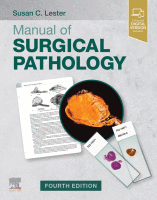Physical Address
304 North Cardinal St.
Dorchester Center, MA 02124

Head and neck specimens are often challenging due to the numerous complex structures and the variety of disease processes that involve them. Sinus Contents Functional endoscopic sinus surgery (FESS) is used as a treatment for patients with chronic sinusitis who…

Gynecologic specimens are removed for a wide variety of both benign and malignant lesions. Uterus RELEVANT CLINICAL HISTORY In addition to age, clinical history is often necessary or helpful for the interpretation of specimens from the uterus ( Table 19.1…

You’re Reading a Preview Become a Clinical Tree membership for Full access and enjoy Unlimited articles Become membership If you are a member. Log in here

Genitourinary pathology includes specimens from the kidney, ureters, bladder, prostate, testis, and penis (see separate chapter for the latter). The kidney may undergo biopsy as part of the evaluation of renal function, the testes may be biopsied for interfertility issues,…

Specimens from the gastrointestinal tract are common. Endoscopic biopsies are often performed to evaluate patients with symptoms (bleeding, diarrhea, malabsorption, symptoms of infection), as well as to evaluate mass lesions (polyps and tumors). Resections are commonly performed for tumors but…

. . Of all organ systems, the skin has the greatest number of pathological lesions, perhaps in part because the skin is subject to a wide variety of environmental exposures, no special procedures are necessary to visualize its surface (therefore…

Cytologic specimens are obtained from patients by minimally invasive methods: Brushings and scrapes (e.g., bronchial brushing, gastrointestinal [GI] brushing, Papanicolaou [Pap] test) Washings (e.g., bronchial washing, bronchoalveolar lavage, peritoneal washing) Fine needle aspiration (FNA) of mass lesions Body cavity effusions…

For structural issues in cardiac pathology, the gross findings are often more critical than microscopic features to render a specific etiologic diagnosis for some cardiac tissues (e.g., valves and hearts). However, for changes in the myocardium, histologic analysis of endomyocardial…

Breast procedures generate many specimens for the evaluation of palpable masses, radiologic lesions, or nipple discharge, as well as for the treatment of malignancy. Clinically significant nonmalignant diseases of the breast are rare – the most common being nonlactational chronic…

Bones are common surgical specimens that may be submitted after reconstructive or joint replacement surgery, as part of a larger soft tissue resection, to diagnose metabolic bone disease, or after resection of tumors primary to bone. Relevant Clinical History In…